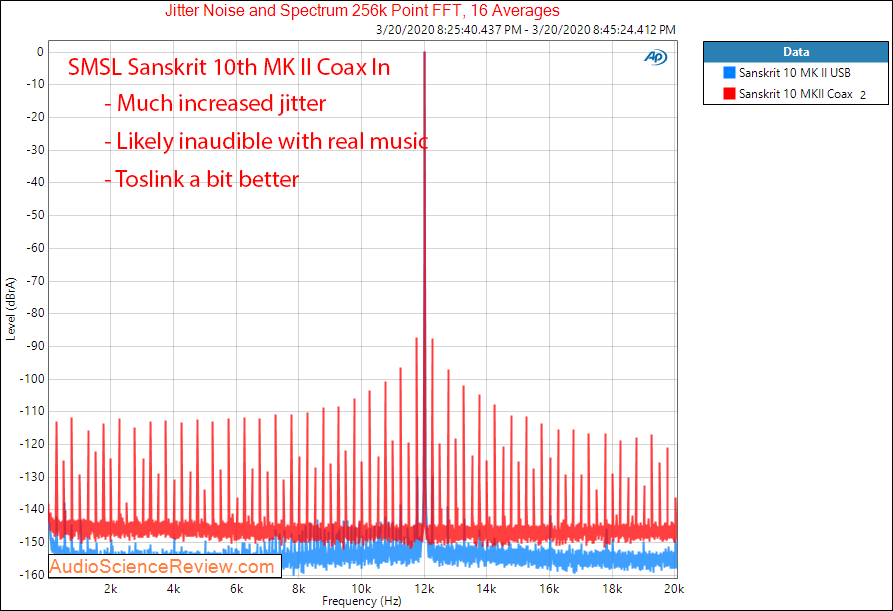Better CD transports sound better. Less electrically noisy PC do too (over USB). I have heard the diffs over many years of futzing with this.
But the audible effects of both of those in the analogue domain are also dependent on the DAC’s ability to deal with them.
That is the problem. Things change, technology gets better. Things we learned years ago no longer apply.
Here’s the jitter performance of my cheap “Chi-Fi” DAC in my office desktop setup - I never listen above 80dBA on my headphones, so the jitter is inaudible. I’d be at hearing damaging levels before jitter became audible…
Not quite. I have a dCS Rossini. I can easily hear the diff between transports, between Roon over USB vs RAAT, and between Roon and Audirvana. So no.
No. I can hear these differences now.
Please stay on topic.
All of the regular guys here say no differences.
I would be very interested to hear from you if you can try it yourself?
The topic of this question is whether someone is able ot hear a difference. A negative is a fine answer. Period.
As said by all of the regular guys, no one hears any difference,
Why would you be looking for a negative answer (whatever it means in plain English)?
The short, technical, answer is no.
If you want to find an answer of “yes” then I’d look at ethernet switches, fiber isolation, different ethernet cables, etc. That is, the stuff which attaches the core to the network. I’d expect you’d find SQ differences there (if improvements were possible there) before you heard any difference in swapping out the core. Only reason the core would make a difference is if it’s causing significant jitter because its too busy trying to keep-up with the stream. That could cause some issues at the streamer which may be audible but Roon is pretty quick to shut down a stream in these situations. A Core with headroom being swapped out for another Core with headroom shouldn’t cause any kind of audible change.
Your gains could be felt in the responsiveness of the Remote though. That might be worth it just for that.
some routers (like mine) or switches have no contact from the ground to the cable shielding. in this case you can’t get noise from the server to the streamer via the shielding. but the shielding itself behaves like an antenna. maybe if on the other side the shielding is connected to the ground of the player (my streaming bridge is connected) you can get ‚noise‘. and then it depends on how the cable was laid and what’s around. but i‘ve never done measurements.
some people heard differences with shielded and unshielded lan cables in my setup. but it depends on the individual taste which version sounded better for him.
Ah, you should have said that earlier! In which case an EtherREGEN feeding a Sonic Transporter i9, then optical from the Sonic Transporter to an opticalRendu and USB from the Rendu to your dCS Rossini should fit the bill nicely!
In your case, the only cable you should be using is UTP.
STP cables are for industrial environments where there are high levels of electrical noise and radio frequency interference. They should only be used with compatible equipment which has the appropriate earthing arrangements.
An answer that says “No I don’t hear a difference” is informative.
I do not want to find the answer yes. I want to know what people have experienced. Those here that have been detailed in their experience have (most) said no there is no SQ difference, and that is informative.
The core cannot cause jitter in this kind of situation - the transmission is completely asynchronous, it gets clocked at the DAC.
You could have a core that is so incapable that the sound will stutter or stop.
as far as I know, stp cables should also be used in cable ducts in which power cables are also laid. this has nothing to do with industrial applications. especially if you are perhaps speculating on an upgrade to more than 1gb/s.
the lan port of the streaming bridge has a ground contact 
Assuming you don’t use ethernet cable with a shield, this does not matter, as ethernet is a differential pair, and there are isolation transformers at the DAC’s end. This is why people should not use ethernet with a shield that has a ground on the plug - this is how you would be connecting ground across the network.
Cat6 UTP is good enough up to 50m with 10Gbit. All of my 10Gbit network is OM3 fibre.
All my cat 6 runs that I ran last year are all under 50m. I would love to go to 10Gbit for my local network but the thought of having to get all new NIC’s and a 10Gbit switch has turned me off a bit on the idea, so i just wait a little longer for things to finish…
